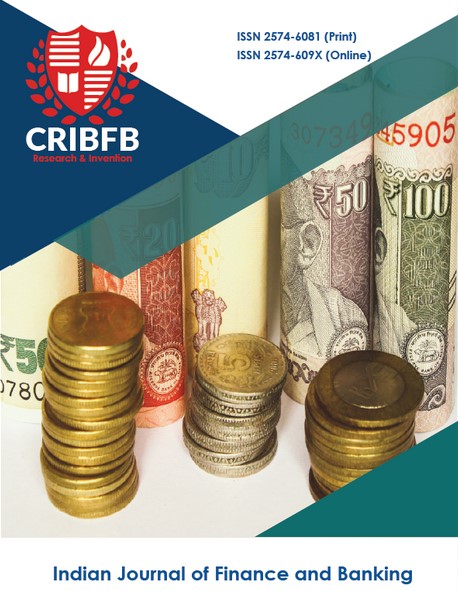Impact of Demographic Traits and Personality Traits of Investors on Their Risk-Bearing Capacity: A Study with Special Reference to Investors of Kerala
Main Article Content
Abstract
Investment decisions form a major part of every individual’s life. Behavioral finance which puts forward a new dimension in the field of finance recognizes that investment decisions are made after considering numerous psychological, economical and social factors. One of the important criteria considered while making any such decision is the risk. It includes uncertainties associated with the investment opportunity as well as the investors’ risk-bearing capacity. Investors’ risk-bearing capacity is in turn determined by numerous other aspects. An effort is made here to determine whether the risk-bearing capacities of investors are influenced by the demographic factors and personality traits. 120 investors of Kerala State were selected as the sample for this purpose. Analytical results indicated that the risk-bearing capacity is dependent on gender, occupation, and monthly income of the investors. Further, it was noticed that those who have low neuroticism scores and high scores in agreeableness, extraversion, and conscientiousness took higher risks compared to others. This indicated that neuroticism trait was found to have a negative correlation with risk-bearing capacity whereas; agreeableness, extraversion, and conscientiousness were found to have a positive relation. The study concluded that factors like demography and personality have a strong influence on an investor’s risk-bearing capacity.
Downloads
Article Details
Section
How to Cite
References
Alwahaibi, S. S. O. (2019). Is Demographic Information Influence Risk Tolerance/Aversion in Investment Decision? Evidences from Literature Review. International Journal of Academic Research in Accounting, Finance and Management Sciences, 9(1), 111–122. https://doi.org/10.6007/IJARAFMS/v9-i1/5825
Asano, S., & Tachibanaki, T. (1994). Relative risk aversion once more: An analysis of Japanese households’ financial asset holding pattern. Financial Engineering and the Japanese Markets, 1(2), 137–154. https://doi.org/10.1007/bf02425194
Croson, R., & Gneezy, U. (2009). Gender Differences in Preferences. Journal of Economic Literature, 47(2), 448–474. https://doi.org/10.1257/jel.47.2.448
Dhiman, B., & Raheja, S. (2018). Do Personality Traits and Emotional Intelligence of Investors Determine Their Risk Tolerance? Management and Labour Studies, 43(1&2), 88–99. https://doi.org/10.1177/0258042X17745184
Dickason, Z., & Ferreira, S. (2018). Establishing a link between Risk Tolerance, Investor Personality and Behavioural Finance in South Africa. Cogent Economics & Finance, 6, 1–13. https://doi.org/10.1080/23322039.2018.1519898
Durand, R. B., Newby, R., Peggs, L., & Siekierka, M. (2013). Personality. Journal of Behavioral Finance, 14(2), 116–133. https://doi.org/10.1080/15427560.2013.791294
Durand, R., Newby, R., Tant, K., & Trepongkaruna, S. (2013). Overconfidence, Overreaction and Personality. Review of Behavioral Finance, 5(2), 104–133. https://doi.org/10.1108/RBF-07-2012-0011
Dwyer, P. D., Gilkeson, J. H., & List, J. A. (2002). Gender differences in revealed risk taking: Evidence from mutual fund investors. Economics Letters, 76(2), 151–158. https://doi.org/10.1016/s0165-1765(02)00045-
Gondaliya, V., & Dhinaiya, G. (2016). Assessing Financial Risk Tolerance: Do Demographic, Socioeconomic and Attitudinal factors work? International Journal of Marketing & Financial Management, 4(5), 32–38.
Grable, J. E. (2000). Financial risk tolerance and additional factors that affect risk taking in everyday money matters. Journal of Business and Psychology, 14(4), 625–630. https://doi.org/10.1023/a:1022994314982
Gupta, C., & Agarwal, K. (2018). Portfolio Investor Personality Traits and Portfolio Investment Decisions: An empirical analysis. International Journal of Commerce and Management Research, 4(5), 12–18. Retrieved from http://www.managejournal.com/download/692/4-4-32-119.pdf
Holton, G. A. (2004). Defining Risk. Financial Analysts Journal, 60(6), 19–25. https://doi.org/10.2469/faj.v60.n6.2669
Isidore, R. R., & Christie, P. (2017). Review of the influence of Investor Personality (The Big 5 Model) on Investor Behavior. International Journal of Research in Finance and Marketing, 7(7), 9–18. Retrieved from http://euroasiapub.org/wp-content/uploads/2017/08/2FMJuly-5203P-1.pdf
Mayfield, C., Perdue, G., & Wooten, K. (2008). Investment management and personality type. Financial Services Review, 17, 219–236. Retrieved from http://citeseerx.ist.psu.edu/viewdoc/download?doi=10.1.1.320.6394&rep=rep1&type=pdf
Outreville, J. F. (2015). The relationship between Relative Risk Aversion and the level of education: A survey and implications for the demand for life insurance. Journal of Economic Surveys, 29(1), 97–111. https://doi.org/10.1111/joes.12050
Thanki, H., & Baser, N. (2019). Interactive impact of Demographic Variables and Personality Type on Risk Tolerance. Emerging Economy Studies, 5(1), 42–54. https://doi.org/10.1177/2394901519825924
Thomas, T. C., & Rajendran, G. (2012). BB&K Five-way Model and Investment Behavior of Individual Investors: Evidence from India. International Journal of Economics and Management, 6(1), 115–127. Retrieved from http://www.ijem.upm.edu.my/vol6no1/bab07.pdf




